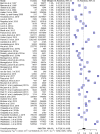Prevalence and factors associated with polypharmacy: a systematic review and Meta-analysis
- PMID: 35854209
- PMCID: PMC9297624
- DOI: 10.1186/s12877-022-03279-x
Prevalence and factors associated with polypharmacy: a systematic review and Meta-analysis
Erratum in
-
Correction: Prevalence and factors associated with polypharmacy: a systematic review and meta-analysis.BMC Geriatr. 2022 Sep 12;22(1):742. doi: 10.1186/s12877-022-03388-7. BMC Geriatr. 2022. PMID: 36096733 Free PMC article. No abstract available.
Abstract
Introduction: Polypharmacy is commonly associated with adverse health outcomes. There are currently no meta-analyses of the prevalence of polypharmacy or factors associated with polypharmacy. We aimed to estimate the pooled prevalence of polypharmacy and factors associated with polypharmacy in a systematic review and meta-analysis.
Methods: MEDLINE, EMBASE, and Cochrane databases were searched for studies with no restrictions on date. We included observational studies that reported on the prevalence of polypharmacy among individuals over age 19. Two reviewers extracted study characteristics including polypharmacy definitions, study design, setting, geography, and participant demographics. The risk of bias was assessed using the Newcastle-Ottawa Scales. The main outcome was the prevalence of polypharmacy and factors associated with polypharmacy prevalence. The pooled prevalence estimates of polypharmacy with 95% confidence intervals were determined using random effects meta-analysis. Subgroup analyses were undertaken to evaluate factors associated with polypharmacy such as polypharmacy definitions, study setting, study design and geography. Meta-regression was conducted to assess the associations between polypharmacy prevalence and study year.
Results: 106 full-text articles were identified. The pooled estimated prevalence of polypharmacy in the 54 studies reporting on polypharmacy in all medication classes was 37% (95% CI: 31-43%). Differences in polypharmacy prevalence were reported for studies using different numerical thresholds, study setting, and publication year. Sex, study geography, study design and geographical location were not associated with differences in polypharmacy prevalence.
Discussion: Our review highlights that polypharmacy is common particularly among older adults and those in inpatient settings. Clinicians should be aware of populations who have an increased likelihood of experiencing polypharmacy and efforts should be made to review the appropriateness of prescribed medications and occurrence of adverse effects potentially associated with polypharmacy.
Conclusions and implications: Clinicians should be aware of the common occurrence of polypharmacy and undertake efforts to minimize inappropriate polypharmacy whenever possible.
Keywords: Administrative database; Multiple medication prescribing; Polypharmacy; Population-based study.
© 2022. The Author(s).
Conflict of interest statement
The authors declare they have no competing interests.
Figures
References
-
- Monégat M, Sermet C, Perronnin M, Rococo E. Polypharmacy: definitions, measurement and stakes involved - review of the literature and measurement tests. Quest d’économie la Santé. 2014;204:1–8.
Publication types
MeSH terms
Grants and funding
LinkOut - more resources
Full Text Sources
Medical



